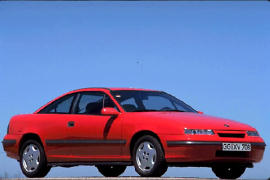OPEL Calibra Models/Series Timeline, Specifications & Photos
First production year: 1989
Engines: Gasoline
Body style: Coupé (two-door)
Opel introduced the Calibra as a replacement for the Manta in 1989, and the car became an instant hit thanks to its affordable price and sporty look.
In the late ‘80s, there were just a handful of affordable, daily-driver coupes on the European market. Opel noticed that and started to work on the Calibra as a sporty alternative to the Vectra midsize sedan. By doing that, the result was an easy-to-drive and maintain vehicle, while it looked like it was ready to race daily, even though some versions were far from being noticeable fast. Opel also tried to create an aerodynamic vehicle since it knew that it played a crucial role in the vehicle’s performance and road behavior. GM employed Erhard Schnell and Steve Lewis to pen the Calibra, and they did a great job. With a drag resistance factor of just 0.26, it became the most aerodynamic production vehicle in the world, a record held for a decade until Honda launched the 1999 Insight with a 0.25 cd.
At the front, the Calibra featured slim horizontal headlights that flanked a one-slat grille. After the 1994 facelift, the badge was moved from the hood to the grille. Underneath, depending on the version, the automaker installed a wrapped-around bumper fitted with an apron and an air intake. A set of rectangular fog lamps were also available.
From its profile, the low-slung bodywork of the Calibra boasted a very raked windshield followed by a curved roof. Depending on the version, it also featured a rear window wiper, which was unusual for most coupes. It also had either black or body-colored door handles and mirrors. Its long doors were without frames for the windows, making it look like it belonged in the premium segment, even though it wasn’t. At the back, the large tailgate featured integrated taillights extended on the rear quarter panels. Underneath the wrapped-around rear bumper, Opel installed a single or dual exhaust.
Opel offered the Calibra with a wide variety of interior options. Base models featured cloth upholstery, while the upper grades boasted leather-wrapped sports seats. In front of the driver, Opel installed a rounded instrument cluster with dials and gauges carried over from the Vectra lineup. On the center stack, the automaker placed the controls for the HVAC and the stereo, which was available with a CD player. Between the front occupants, the Calibra had a center console that housed the gear stick (or the gear selector for the automatic transmission) and the handbrake. At the back, the split-folding bench seat offered enough room for two passengers, albeit headroom was nothing to write home about.
Under the hood, Opel installed a two-liter gasoline engine with two or four valves per cylinder. Later, it added a turbocharged unit developed by Cosworth and a V6. Depending on the version, the Calibra’s engines were paired with either a five- or a six-speed manual or a four-speed automatic. While most versions sent their power to the front wheels, selected versions were available with an all-wheel drive system.
OPEL Calibra 2.0L 16V 4AT FWD (136 HP)
OPEL Calibra 2.0L 16V 4AT FWD (150 HP)
OPEL Calibra 2.0L 16V 5MT AWD (150 HP)
OPEL Calibra 2.0L 16V 5MT FWD (136 HP)
OPEL Calibra 2.0L 16V 5MT FWD (150 HP)
OPEL Calibra 2.0L 4AT FWD (116 HP)
OPEL Calibra 2.0L 5MT AWD (116 HP)
OPEL Calibra 2.0L 5MT FWD (116 HP)
OPEL Calibra 2.0L Turbo 6MT AWD (204 HP)
